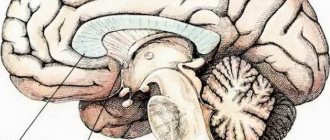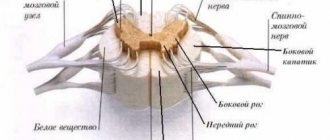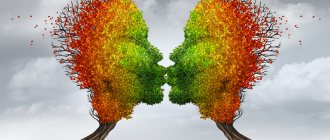Age-related personality crises are alternating, temporary manifestations of changes in a person’s psychological attitude to the surrounding reality, depending on the age period. As a rule, this kind of phenomenon is negative in nature, which can help stimulate not only the stress effect on the human psyche, but also the development of certain psychopathological conditions and disorders, for example, anxiety, phobias, depressive-like disorders, and so on.
In some cases, to prevent the development of pathological conditions, it is necessary to intervene with a specialist and prescribe medications to help the condition. However, it is worth noting that age-related personality crises are a physiologically normal phenomenon that occurs in the majority of people and contributes to the direct development of personality, which is caused by a change in life values. But not all psychologists and psychotherapists agree with this statement; some of them quite confidently believe that the emergence of age-related crises in men and women is a pathological process, due to a number of etiological reasons and dependencies. And this must be treated like any mental disorder or disorder.
The strength of manifestation and the period of age-related crises are always different, although there is a certain link to a certain age. However, it is rather conditional, since only the individual characteristics of a person, surrounding social and microsocial factors, are decisive.
In domestic psychotherapy, the research of L. S. Vygotsky, who did not consider the age crisis as a pathology, plays an important role. He believed that a smooth transition into the next age crisis, especially in childhood, contributes to the formation of a stronger personality with strong-willed resistance to negative manifestations of the environment. However, such a phenomenon is appropriate provided that not only the smooth emergence of the crisis period, but the correct attitude of others, or psychological specialists, if their intervention is necessary.
In addition, according to L. S. Vygotsky, a sharp jump into the crisis phase and its successful overcoming contributes to the formation of a new round of character in human psychology - factors that contribute to giving some descriptive characteristics to the individual.
WHAT TYPES OF CRISES DO CHILDREN HAVE
Psychologists, compiling a child development calendar, have identified the main ones that parents of babies, schoolchildren and teenagers face. It highlights several major crises that can significantly ruin life. This:
— newborn crisis: begins when the baby takes its first breath;
- 1 year crisis: during this period the baby begins to receive frames;
— 3-year crisis: this period is often characterized as “I am a creator”;
— crisis at age 7: the child begins to associate himself as a full-fledged member of society;
- adolescence: the main cause of this crisis is puberty.
NEWBORN CRISIS: WHAT ARE ITS FEATURES
Crises, according to doctors, are necessary for humans, because... allow him to develop, and not stagnate on the same psychological level. One of the longest is the neonatal crisis, which will smoothly flow into the 1-year crisis. If you look at the development calendar of a child up to 1 year old, you can understand that the baby is not stormy at all like a child. After all, every new crisis for him begins once every three months.
The very first crisis is newborns. It occurs at the very moment as soon as the baby is born. Such a crisis often manifests itself with the first cry or in the arms of the midwife who received the baby. This crisis is considered one of the most difficult, because... a person experiences the greatest shock - he finds himself in a huge world. A complete change in physical parameters also has an effect. He lived in the womb for 9 months, and here there was a bright light, a breeze, voices, voluminous space - and everything so unfamiliar and incomprehensible. Naturally, it is very difficult for a baby to cope with such an avalanche of new information.
The kid understands that now he needs to survive as an independent unit, while the world around him is completely unfamiliar to him. The natural feeling that arises as a response to this is fear. And there is only one thing that gives him peace at this moment - his mother.
The newborn crisis continues to develop further. For example, babies sleep for a long time. It seems to many that their sleep is sound at this moment, and the baby is gaining strength. In fact, psychologists characterize this dream as a semi-reality, when the baby is in a borderline state and disoriented in space. All the cries of a child when he wakes up are a sign of his uncertainty and insecurity. An excellent means of calming a baby at this moment is the mother’s breast. In order to get through this crisis with dignity and not leave any special consequences for the child, the mother must always manage to arrive on time so that the baby makes sure that he is not abandoned, but loved. During this period, according to psychologists, the child lays the foundations of trust in the world.
A young mother should prepare for the fact that the first month of the baby’s life will be quite alarming. Therefore, her task is to ensure his calm and harmonious development. You should not bring down an avalanche of your tenderness and love on your baby - do everything in doses.
The signal that the newborn crisis is over will be the so-called revival complex, when a smile begins to appear on the baby’s face at the sight of the mother, violent motor reactions begin to be noted (jerking legs and arms), and humming begins. This will mean that the baby has grown enough and is entering the crisis of infancy.
CRISIS OF INFANCY: WHAT IS ITS IMPORTANCE
The newborn crisis is replaced by an infancy crisis, which will last until the baby is one year old. If you look at the child’s development calendar by month, you will see that he will begin to acquire new skills literally every couple of months.
A baby, unlike a newborn, is already beginning to build his own emotional framework with the people close to him. Among the main achievements that he must achieve by 12 months: communication with adults, crawling, walking, ability to sit down and stand up. Also, the baby must learn to associate objects, pick up toys and move to a full-fledged table.
Many parents are surprised at how quickly the baby develops during this period. And it is really spasmodic. In no other age form will you find such rapid changes. In the first three to four months, the baby should learn to recognize objects, and by the age of one year he should already be able to form a complete image of them.
It is at the moment of the crisis of infancy that the baby experiences personality development. His emotions are already changing, the range of which can become much wider; he begins to experience a feeling of anxiety when strangers appear next to him, learn to communicate and communicate with others.
When the time comes for the baby to stand on his feet and walk, he has a clear division: me and the adult. Now he is no longer so dependent on an adult - he can go wherever he wants. And as he gains more autonomy, prohibitions are already being introduced to him. As a result, the crisis of infancy carefully and systematically turns into a crisis of 1 year.
Text of the book “Age Crises”
I. G. Malkina-Pykh Age crises
About the author:
Irina Germanovna Malkina-Pykh – psychologist, Doctor of Physical and Mathematical Sciences in the field of system analysis and mathematical modeling of complex biophysical systems, leading researcher in the Department of Human Ecology of the Center for Interdisciplinary Research on Environmental Problems of the Russian Academy of Sciences (INENKO RAS), author of the books “Handbook of Practical Psychologist”, St. Petersburg. – Moscow, “Eksmo”, 2002, and “Psychosomatics. The newest reference book", St. Petersburg. – Moscow, “Eksmo”, 2003.Reviewers:
Doctor of Psychology, Professor B.V. Kaygorodov;
Doctor of Medical Sciences, corresponding member. Russian Academy of Natural Sciences (RAE) O.D. Barnaulov.
INTRODUCTION
The book brought to your attention is a reference guide on psychological counseling, psychocorrection, psychotherapy in situations of age-related, or normative, crises in a person’s life.
Crisis, from the Greek krineo, literally means "parting of the roads." In Chinese, the word "crisis" is made up of two characters, one meaning "danger" and the other meaning "opportunity." Thus, the word “crisis” carries with it connotations of emergency, threat and the need for action. The very concept of “crisis” really means an acute situation for making some kind of decision, a turning point, a critical moment.
A crisis is defined psychologically as a situation of impossibility, the impossibility of further existence in the previous status, that is, a situation in which a subject is faced with the impossibility of realizing the internal needs of his life (motives, aspirations, values). When mentioning a crisis, we mean an acute emotional state that arises in a situation where an individual collides with an obstacle to satisfying his most important life needs, an obstacle that cannot be eliminated by methods of solving the problem known to the individual from his past life experience. A psychological crisis is an internal disturbance of emotional balance that occurs under the influence of a threat created by external circumstances.
Crises can be classified based on various principles, based on predictability or unpredictability, cause of occurrence, etc. They vary in duration and intensity. Based on their content, there are three main types of crises: neurotic crises, developmental crises and traumatic crises. Also in psychology, age-related crises
and
situational crises.
Situational crises are crises that arise as a result of any sudden or unexpected events.
Age is a qualitatively specific stage of human ontogenetic development. Each age in human life has certain standards with the help of which one can assess the adequacy of an individual’s development and which relate to psychophysical, intellectual, emotional and personal development. These standards are also designated as age-related development goals. The transition to the next stage occurs in the form of crises of age-related development, or age-related crises. These are relatively short periods of ontogenesis (up to a year), characterized by sharp psychological changes. The form, duration and severity of the crisis can vary significantly depending on the individual typological characteristics of a person, social and microsocial conditions.
In Russian psychology, the term “age crisis” was introduced by L.S. Vygotsky and defined as a holistic change in a child’s personality that regularly occurs when stable periods change. According to Vygotsky, the age crisis is caused by the emergence of major new formations of the previous stable period, which lead to the destruction of one social situation of development and the emergence of another, adequate to the new psychological appearance of the child. The mechanism of changing social situations constitutes the psychological content of the age crisis.
A number of researchers consider age-related crises to be a normative process, a necessary element of socialization, conditioned by the logic of personal development and the need to resolve the main age-related contradiction (3. Freud, E. Erikson, L. Vygotsky, L. Bozhovich). Other authors see age-related crises as a deviant, malignant manifestation of individual development (S.L. Rubinshtein, A.V. Zaporozhets).
There are eight age-related crises. Five of them occur in childhood. In time, they are localized at the boundaries of stable ages and manifest themselves as a newborn crisis (up to 1 month), a one-year crisis, a 3-year crisis, a 7-year crisis, an adolescent crisis (11–12 years) and a youth crisis. The sixth is characteristic of young adults. The seventh crisis is experienced at the age of forty (plus or minus two years). The eighth and final crisis of the life course is experienced during aging.
Practical psychology of age-related crises is a little developed area today. The reason, apparently, is that initially practical psychology was built on methodological foundations other than the psychology of age-related crises. In addition, developmental psychology has studied the development of children and adolescents in the most detail. And this is understandable, since during these periods development occurs very quickly and is directly related to growth and physiological changes. It is largely determined by external factors, and intermediate results are observable. As a rule, cases of difficult age-related crises in adults are considered simply as individual biographical complications without taking into account age specifics. This complicates the therapy process, and sometimes it does not achieve its goal.
That is why in this reference book a very significant place is occupied by the issue of psychotherapy (individual and group) for crises of adulthood.
The main feature of going through a crisis is that a person always himself, and only himself, can survive the events, circumstances and changes in his life that gave rise to the crisis. No one can do this for him, just as the most experienced teacher cannot understand the material being explained for his student. But the process of experiencing can be controlled to some extent - stimulated, organized, directed, provided with favorable conditions for it, striving to ensure that this process leads to growth and improvement of the individual or, at least, does not follow a pathological or socially unacceptable path , such as alcoholism, drug addiction, substance abuse, the formation of drug dependence, neuroticism, psychopathization, suicidal behavior.
We wanted to offer a practicing psychologist, consultant, or psychotherapist a guide that could be immediately used in working with problems of age-related crises. What does a psychologist (consultant, psychotherapist) need to know in order to try one of the techniques when working with a certain age-related crisis? What difficulties might he experience? What traps might lie in wait for him?
This reference book is, first of all, a collection of techniques, or more precisely, a collection of exercises that a psychologist (psychotherapist, consultant) can use in his practical work. It was this approach that determined the selection and arrangement of material in the reference book. The structure of the book is distinctly practical; it is written as a reference guide on effective techniques of psychotherapy and psychocorrection during periods of age-related crises, developed to date in various psychotherapeutic schools. This book is a guide for practicing psychologists and counselors working in various institutions (public and private clinics, schools, hospitals and community health centers).
CHAPTER 1 PSYCHOLOGY OF AGE CRISES
1.1. THEORIES OF INDIVIDUAL HUMAN DEVELOPMENT
The idea of development came to psychology from other areas of science. The road to its scientific study was paved by Charles Darwin’s famous work “The Origin of Species by Means of Natural Selection...”, published in 1859. The influence of this theory, according to I.M. Sechenov, was that she forced natural scientists to “recognize in principle the evolution of mental activities” (Rean, 2003).
Development, first of all, is characterized by qualitative changes, the emergence of new formations, new mechanisms, new processes, new structures.
The question of the possibility of identifying periods of life in which the development of personality is subject to special laws has a long history. Thus, even the ancient Greeks divided human life into 10 periods of 7 years each - heptomadens, and the Romans divided life into 5 phases of 13–15 years each (Livehud, 1994).
However, despite such a long history of the problem, the question of whether personality development is divided into periods, or whether it occurs continuously and one can only talk about a consistent change in forms of behavior remains open to this day. There are discussions about the basis for distinguishing periods and their boundaries. This is especially true for the periodization of adult development.
The science of mental development of personality originated as a branch of comparative psychology at the end of the 19th century. There is practically not a single outstanding psychologist who would not simultaneously deal with problems of mental development in one way or another.
The most significant achievements in this area are associated with the names of such famous scientists of the first third of the 20th century as A. Adler, A. Binet, J. Baldwin, Karl and Charlotte Bühler, A. Gesell, E. Claparède, J. Piaget, 3. Freud, S. Hall, V. Stern, B. Arkin, M.Ya. Basov, P.P. Blonsky, L.S. Vygotsky, A.B. Zalkind, A.P. Nechaev, G.A. Fortunatov and others. In subsequent years, domestic scientists B.G. made their contribution to the understanding of various aspects of human mental development. Ananyev, L.I. Bozhovich, P.Ya. Galperin, V.V. Davydov, A.N. Leontyev, M.I. Lisina, A.R. Luria, A.V. Petrovsky, S.L. Rubinstein, D.B. Elkonin, as well as prominent representatives of foreign psychology A. Bandura, D. Bowlby, W. Bronfenbrenner, A. Vallon, X. Werner, L. Kohlberg, B. Skinner, E. Erikson and others.
Age periodization in psychology is usually understood as a model of personality development that reflects the essence of ongoing age-related changes and involves the identification of individual stages of development, each of which is characterized by both the originality of the structure and functioning of various mental processes and special personal new formations.
The content of any of the periodizations of age development is determined by the criterion that underlies its construction, that is, the sign on the basis of which the assessment, definition or classification of individual periods of development is made.
The problem of age-related periodization of mental development is one of the most controversial in psychology, which is due to the lack of a common understanding among different researchers of the nature of age-related development, its driving forces and mechanisms. Each of the theories of personality gives rise to a certain scheme for the periodization of mental development. Moreover, there are not only a large number of theories and periodization schemes, but also a large number of classifications of these theories.
First
From the classification schemes for the periodization of individual development of the individual and his self-awareness, he distinguishes three approaches depending on what science we are talking about.
In biology and psychophysiology we are talking about critical, or sensitive, periods, when the body is characterized by increased sensitivity (sensitivity) to some well-defined external and (or) internal factors, the impact of which is particularly significant at this (and no other) point of development. important irreversible consequences.
In sociology and other social sciences they talk about social transitions, turning points in development that radically change the position, status or structure of an individual’s activities (for example, entering school, coming of age, getting married), which are often accompanied by special social rituals and rites of passage. Social anthropology says that the transition to the next age period should be accompanied by a change in a person’s social status, social roles performed and life activity. Consequently, the basis for identifying periods of development can be considered the position of a person in the system of social relations.
In developmental psychology, there is a special concept of age-related normative life crises, which emphasizes that critical periods and social transitions are usually accompanied by some kind of psychological restructuring. No matter how painful this restructuring may seem, for this phase of development it is natural, statistically normal. Knowing the relevant biological and social laws, it is possible to predict quite accurately at what age an individual in a given society will encounter certain problems, how these problems are related to each other, what determines the depth and duration of the crisis and what are the typical options for resolving it.
Second
the classification of periodization schemes considering the period of childhood is also divided into three groups (Vygotsky, 1984).
The first group includes attempts to periodize age-related development on the basis not of dividing this development itself, but of correlating it with step-like changes in other processes, one way or another related to child development (A. Getchinson, V. Stern, R. Zazzo, etc.).
The second group includes periodizations aimed at highlighting any one sign of child development as a conditional criterion for dividing it into separate periods (P.P. Blonsky, G. Sullivan, Z. Freud, etc.).
The third group is represented by periodizations that take as a basis the essential characteristics of a personality at different stages of its mental development (L.S. Vygotsky, A. Gesell, D.B. Elkonin, A.V. Petrovsky). The desire of the authors of these periodizations to move from symptomatic and descriptive principles to highlighting the essential features of age-related development led them to comprehend its cyclical nature. Such, for example, is A. Gesell’s attempt to construct a periodization of child development based on changes in its internal rhythm and tempo (cited from: Vygotsky, 1984; Elkonin, 1970).
Third
the classification of schemes for the periodization of individual development is based on the views of their authors on ontogeny. In psychology, mainly child and developmental, ontogenesis is understood as the period of an individual’s life from birth to adulthood.
Representatives of the first direction consider development in its integrity and indivisibility, without identifying clearly defined individual periods or stages in it (G. Allport, J. Cattell, K. Rogers, G. Eysenck, etc.). In the theories of this group, as a rule, the idea of some integrity, for example the concept of personality, is put at the forefront. Further, the subject of research becomes the characteristics of this integrity, its internal structure, and the conditions of origin. Even recognizing the dynamics of changes in this integrity and studying the conditions of its origin, researchers do not strictly associate these changes with any specific age. Age-related development in this case is recognized as the background of the changes being studied.
The second group is formed by those psychological theories in which ontogenesis represents an alternation, a change of certain periods of development (3. Freud, J. Piaget, A. Vallon, E. Erikson, L.S. Vygotsky, A.N. Leontiev, etc.) . For a reasonable division of ontogenesis into certain periods, each researcher introduces his own basis for this division and presents his own theory of human mental development in ontogenesis.
The theories of the first and second groups may agree in recognizing the existence of periods of development, but fundamentally diverge in their answer to the question of the content of transitions from one period to another.
And finally, A.G. Asmolov, analyzing theoretically possible approaches to explaining human development, identifies three main ones, into which many individual theories and concepts fit (Asmolov, 1998):
Biogenetic
approach, the focus of which “is on the problems of human development as an individual with certain anthropogenetic properties (inclinations, temperament, biological age, gender, body type, neurodynamic properties of the brain, organic impulses, etc.), who goes through various stages of maturation as he realizes phylogenetic program in ontogenesis".
• Sociogenetic
an approach whose representatives focus on the study of the processes of “socialization of a person, his mastery of social norms and roles, acquisition, social attitudes and value orientations...”. Apparently, learning theories (B. Skinner, A. Bandura) can also be included in this direction, according to which a person’s acquisition of various forms of behavior occurs through learning.
• Personogenetic
an approach that puts at the forefront “the problems of activity, self-awareness and creativity of the individual, the formation of the human “I”, the struggle of motives, the education of individual character and abilities, the self-realization of personal choice, the constant search for the meaning of life during the life path of the individual.”
To those named A.G. Cognitive theories can be added to Asmol's approaches. They occupy an intermediate direction between biogenetic and sociogenetic approaches, since both the genotypic program and the conditions in which this program is implemented are considered the leading determinants of development. Therefore, the level of development (level of achievement) is determined not only by the development of the genotype, but also by the social conditions due to which the child’s cognitive development occurs (Rean, 2003).
Thus, most psychologists agree that development consists of a sequence of slow smooth and fast abrupt changes and the identification of stages of development is not only necessary, but also possible. However, most often researchers limit themselves to the periodization of childhood. This is primarily explained by the greater complexity of the periodization of adulthood, when development takes on a new character: it is not directly associated with physical maturation and the acquisition of new cognitive skills and is to a greater extent determined by the internal subjective position of a person, i.e., it takes on a qualitatively new form of self-development.
When describing the development of adults, it is also necessary to take into account intrapersonal and interpersonal heterochrony, i.e., the discrepancy between the rates of development of various processes (biological, social, cognitive) in one person and the discrepancy between these rates in different people.
In addition, we must remember that the development of adults, during which the most important personal choices are made (professional, attitude towards love, marriage, family, friends, values, one’s way of life), is the sum of not only evolutionary, but also involutionary processes. As noted by V.L. Efimenko (1975), the physiological prerequisites for personal involution appear already at a young age, and at the age of 40 significant physiological changes are observed. Thus, the first involutional psychoses are possible at the age of 40. Thus, when speaking about development in adulthood, in contrast to childhood, one must bear in mind the emergence of not only positive, but also negative qualitative changes.
Today, gender psychology has become widespread, so there is no doubt that it is necessary to approach the periodization of the lives of men and women differently. Although women and men are found to face similar development challenges and face the same crises, their particularities differ significantly. Moreover, there is an opinion that for women, the phases of the family cycle are a better indicator of transitions from stage to stage than age.
In addition to the noted factors that complicate the periodization of adulthood, it is necessary to add one more, perhaps the most significant. To describe the development of an adult, it is not enough to distinguish only biological and mental lines. It is also necessary to consider the spiritual aspect of life, since it not only significantly influences the dynamics of development, but also determines qualitative changes. Thus, B. Livehud (Livehud, 1994), considering human development in three aspects - biological, mental and spiritual, notes that from the moment a person is born until about 40 years of age, mental and spiritual functions develop in parallel with biological ones. However, from about 40 years of age, significant physical involution begins. Further, two options for the movement of the psyche are possible: either mental involution runs parallel to the physical, or mental and spiritual evolution continues. The second option requires a sufficiently high level of spiritual development. It turns out that the 40-year mark, according to B. Livehud, is a kind of “point of diverging paths.” Thus, without considering the spiritual aspect of human development, it is impossible to determine the quality of the second half of his life.
In this chapter we will briefly review some of the basic theories of individual human development.
At the same time, firstly, we will consider only those of them that explicitly contain the periodization of individual development. This choice is determined by the fact that the possibility of initially assuming the existence of a critical transition from one period to another appears only if maturation (or development throughout life) is considered to consist of separate phases, stages or periods - separate segments of the life path. If some psychological concept, even using the term “development,” does not include the idea of individual segments of the life cycle, the idea of crisis, transition, change does not arise. With this approach, it makes no sense to raise the question of a crisis, a critical age.
Secondly, we will consider development theories without using any classification schemes, since many of the existing theories, strictly speaking, cannot be attributed “in their pure form” to any of these approaches.
S. HALL'S THEORY OF RECAPTULATION
S. Hall (Hall and Lindsay, 1997) considered the main law of developmental psychology to be the biogenetic “law of recapitulation,” according to which individual development, ontogenesis, repeats the main stages of phylogenesis. Infancy reproduces the animal phase of development. Childhood corresponds to an era when the main activities of ancient man were hunting and fishing. The period from 8 to 1 2 years, which is sometimes called pre-adolescence, corresponds to the end of savagery and the beginning of civilization. Adolescence, spanning the period from the onset of puberty (ages 12–13) to adulthood (ages 22–25), is equivalent to the Romantic era. The superficial analogies on which the “law of recapitulation” is based prevent us from understanding the specific patterns of mental development.
PSYCHOANALYTICAL THEORY OF S. FREUD
An analysis of patients' free associations led Freud to the conclusion that illnesses of the adult personality are reduced to childhood experiences. Childhood experiences, according to Freud, are of a sexual nature. This is a feeling of love and hatred towards a father or mother, jealousy towards a brother or sister, etc. Freud believed that this experience has an unconscious influence on the subsequent behavior of an adult, and also plays a decisive role in personality development (Freud, 1991).
Personality, according to Freud, is the interaction of mutually stimulating and restraining forces. Libidinal energy, which is associated with the life instinct, is also the basis for the development of personality and human character. Freud said that in the process of life a person goes through several stages that differ from each other in the way they fix libido, in the way they satisfy the life instinct. At the same time, Freud pays great attention to exactly how fixation occurs and whether a person needs foreign objects. Based on this, he identifies several stages - stages of mental genesis during the life of a child.
Oral stage
(from birth to one year) is characterized by the fact that the main source of pleasure, and therefore potential frustration, is concentrated in the area of activity associated with feeding. The oral stage is characterized by two sequential libidinal actions (sucking and biting). The leading erogenous area at this stage is the mouth, an instrument of feeding, sucking and initial examination of objects. At the oral stage of libido fixation in a person, according to Freud, certain personality traits are formed: gluttony, greed, demandingness, dissatisfaction with everything offered. Already at the oral stage, according to his ideas, people are divided into optimists and pessimists.
Anal stage
(1–3 years). At this stage, libido is concentrated around the anus, which becomes the object of attention of the child, accustomed to neatness. Now children's sexuality finds the object of its satisfaction in mastering the functions of defecation and excretion. Here the child encounters many prohibitions, so the outside world appears before him as a barrier that he must overcome, and development takes on a conflicting character. In relation to the child’s behavior at this stage, we can say that the “I” instance is fully formed and is now able to control the impulses of the “It”. Social coercion, punishment from parents, fear of losing their love force the child to mentally imagine certain prohibitions and internalize them. In this way, the child’s “Super-I” begins to form as part of his “I”, where the authorities, the influence of parents and adults who play a very important role in the child’s life are mainly based. Character traits that are formed at the anal stage, according to psychoanalysts, are neatness, neatness, punctuality; stubbornness, secrecy, aggressiveness; hoarding, thriftiness, penchant for collecting.
Phallic stage
(3–5 years) characterizes the highest level of childhood sexuality. The genital organs become the leading erogenous zone. Until now, children's sexuality was autoerotic, now it is becoming objective, that is, children begin to experience sexual attachment to adults. The first people who attract a child's attention are parents. Freud called libidinal attachment to parents of the opposite sex the Oedipus complex for boys and the Electra complex for girls, defining them as the motivational-affective relationship of the child to the parent of the opposite sex.
Latent stage
(5-12 years) is characterized by a decrease in sexual interest. The psychic authority “I” completely controls the needs of “It”; being divorced from a sexual goal, libido energy is transferred to the development of universal human experience, enshrined in science and culture, as well as to the establishment of friendly relationships with peers and adults outside the family environment.
Genital stage
(12–18 years old) is characterized by the return of childhood sexual desires, now all former erogenous zones are united, and the teenager, from Freud’s point of view, strives for one goal - normal sexual communication. However, its implementation can be difficult, and then during the genital stage one can observe phenomena of fixation or regression to one or another of the previous stages of development with all their features. At this stage, the “I” agency must fight against the aggressive impulses of the “It”, which again make themselves felt. So, for example, at this stage the Oedipus complex may re-emerge, which pushes the young man towards homosexuality, the preferred choice for communication with people of the same sex. To fight against the aggressive impulses of the “It,” the “I” instance uses two new defense mechanisms: asceticism and intellectualization. Asceticism, with the help of internal prohibitions, inhibits homosexual tendencies, and intellectualization reduces them to a simple representation in the imagination and in this way allows the teenager to free himself from these obsessive desires.
EPIGENETIC CONCEPT OF E. ERICKSON
Erik Erikson, a student of Freud, based on Freud's theory of the phases of psychosexual development, created a new theory - psychosocial
development. It includes eight stages of development of the “I”, at each of which guidelines in relation to oneself and the external environment are worked out and clarified (Erikson, 1996). Erikson noted that the study of personal individuality becomes the same strategic task of the second half of the 20th century as the study of sexuality was during the time of Freud, at the end of the 19th century. First of all, Erikson's theory differs from Freud's theory in the following ways:
• Erikson's 8 stages are not limited only to childhood, but include the development and transformation of personality throughout life from birth to old age. Adulthood and mature age are characterized by their own crises, during which the corresponding tasks are solved.
• In contrast to Freud's pansexual theory, human development, according to Erikson, consists of three autonomous, although interrelated processes: somatic development, studied by biology; the development of the conscious self, studied by psychology, and social development, studied by the social sciences.
The basic law of development, according to Erikson, is the “epigenetic principle,” according to which at each new stage of development new phenomena and properties arise that were not present at the previous stages of the process.
Stages of mental development according to Erikson:
1. Oral-sensory.
Corresponds to the oral stage of classical psychoanalysis. Age: first year of life. The task of the stage: basic trust versus basic distrust. Valuable qualities acquired at this stage: energy and hope.
The degree of trust an infant has in the world depends on the care shown to him. Normal development occurs when his needs are quickly met, he does not experience prolonged illness, he is rocked and caressed, played with and talked to. The mother's behavior is confident and predictable. In this case, trust in the world into which he has come is developed. If he does not receive proper care, mistrust, timidity and suspicion develop.
2. Muscular-anal.
Coincides with the anal stage of Freudianism. Age: second or third years of life. Stage challenge: autonomy versus shame and doubt. Valuable qualities acquired at this stage: self-control and willpower.
At this stage, the development of independence based on motor and mental abilities comes to the fore. The child masters various movements. If parents leave the child to do what he can, he develops the feeling that he controls his muscles, his impulses, himself and, to a large extent, his environment. Independence appears.
CRISIS OF YEAR 1: HOW TO DEAL WITH YOUR BABY’S DESIRE AND CORRECTLY BUILD YOUR BEHAVIOR WITH HIM
The one-year crisis is often also called the age crisis. After all, the baby becomes more active, stands on his feet, and now new surfaces are available for him to explore. In addition, now he wants to go where he wants, and not his mother. But it is advisable that she accompany him - after all, it’s still scary.
As this crisis develops, it is very important to let the baby understand that although he has begun to walk and become more independent, he has not yet grown up. Mom and dad are adults and independent, they know and can do more. But it is precisely the awareness of this that causes a violent protest in the child - he begins to show his character.
Psychologists say that when a baby goes through this crisis, it seems to him that you are putting restrictions on him because you simply don’t love him. And you don’t give him that tasty stub from the garbage can just out of harm’s way. Hence the whims and scandals that can accompany this leap in development.
The goal of the parents at this moment is not to overcome the little man’s stubbornness, but to teach him to use his independence for business. For example, show him how to wash his hands, how to eat properly and gracefully, how to press the doorbell when you return from the street.
But you can’t shout, swear and insist on your own all the time. The frames must be built softly, only then will they be useful.
The essence of the concept
In psychology, a crisis is a short period in an individual’s life that precedes the transition to a new stage of personal development.
This period is characterized by various changes in both physical and psychological state.
Each person experiences crises differently. Some undergo them painlessly , while for others they involve some difficulties. After all, an old but familiar situation is collapsing, a person has to leave his comfort zone and look for new roads.
A crisis is an opportunity to analyze your life, think, choose a new goal that is more consistent with the current level of the individual.
Although in psychology it is customary to distinguish a “crisis age,” the onset of a turning point occurs at different times for everyone . For example, women experience the so-called midlife crisis earlier than men.
The course of transition periods is also individual. The intensity of manifestations and duration depend on various factors: level of education, social environment, marital status, relationships with loved ones, etc.
Age-related crises are often associated with changes in emotional state . People begin to experience depressive moods, nervousness, and attacks of apathy. Children show capriciousness, disobedience, and conflict.
While childhood crises have been well studied, adults remain completely unknown.
There is also no consensus on this matter. Some psychologists believe that human development and life should proceed harmoniously and without drastic changes .
In their opinion, the crisis is the result of poor upbringing and spoiling. However, most scientists do not deny the existence of transition periods.
A crisis does not start suddenly. In its development it goes through several stages:
- Pre-critical stage . Some contradictions arise between the individual and the external environment. He suddenly realizes that he is not living like this and wants to change the situation.
- Critical stage .
Contradictions are growing, a person is trying to realize his ideas about an ideal life. At this stage, he is faced with the impossibility of turning his desires into reality and an internal conflict occurs. The conflict ends with the person adjusting desires in accordance with the surrounding reality. - Post-critical stage. The personality rethinks its aspirations, accepts new forms of life and a new reality, real and not existing in dreams. From this moment on, his harmonious existence continues.
WHAT FEATURES DOES THE 3-YEAR CRISIS HAVE?
The 3-year-old crisis is perhaps one of the most difficult for parents. After all, by this time the child has already become quite strong, matured and begins to actively show his character and form his personality. The main characteristics of this age are stubbornness, willfulness and denial. The child begins to have “I’m on my own” attacks. You can often hear hysterics, such as “I wanted to go there/choose a different road/play on a different playground,” especially from 3-year-old children. He also begins to perform all actions out of spite and vice versa.
As a rule, such antics on the part of the child make the parents very angry. They begin to get nervous and push the baby, resulting in an even greater conflict. Of course, you shouldn’t completely ignore this behavior, but it’s better to help your child overcome anger and negativity, because he still doesn’t know how to competently deal with his emotions.
Remember that a child can be overcome at the very beginning of a tantrum. If he is already at its peak, just wait it out. Mom needs to stay calm. Often psychologists recommend applying the theory of choice during this period, i.e. Give your child the opportunity to choose for himself. But, naturally, from a limited number of actions. For example, ask him to choose: will you wear a red or blue cap? Will you eat the soup with a large spoon or a medium one?
Of course, the child must be praised during this period. He cannot yet cope with his behavior on his own, and he needs help and assessment from the outside. Don’t be too quick to criticize - try to gently and unobtrusively say what you don’t like about your baby’s graying hair.
CRISIS OF ADULTITY – 7 YEARS OLD: WHAT TO PAY ATTENTION TO
A crisis in a child at the age of 7 is considered a turning point from the point of view of the child’s development. Its main features are often called disobedience, mannerisms and various antics. The child becomes simply uncontrollable, responds poorly to parents’ comments and does not respond to them at all, begins to pretend that he does not want and cannot hear what adults say, and can even go into open conflict.
This crisis is based on the intellectual component. The child can already build a connection between an action and an experience. Now for him the rules proposed by the parent are an example of the world of childhood, but he wants adulthood, and he diligently refuses to fulfill the demands of his parents.
In addition, a seven-year-old already has a need for social interaction. This is also based on the fact that at this moment children become schoolchildren, which also leads to the development of “adulthood” in them.
The crisis of adolescence, as a rule, has a hormonal basis and follows the scenario that you laid out for the child earlier. The main thing to understand is that it’s hard for a teenager now too. And we need to find a way out of the situation together so that this crisis passes as less painfully as possible.
How to help a child overcome a crisis?
First of all, parents need to be patient. A crisis is a temporary matter and soon all its manifestations will fade away, provided that those close to you take a reasonable position. If attentive parents promptly notice the changes taking place in the child and coordinately build relationships in the family, then the course of the crisis will be significantly mitigated.
In this situation, parents will come to the aid of knowledge of the basics of developmental psychology, knowledge of methods and techniques of education. It is extremely important to coordinate the requirements for the child so that he understands what can and cannot be done.
You cannot act inactively and let everything take its course. The child is not able to control the development process. It is necessary to guide him, to show some rigor, but it is also extremely important to provide the baby with the opportunity to act independently.
Excessive control and rigidity in parenting can provoke additional negativity and aggression in a child. Therefore, first of all, the child must be surrounded with care, love and attention. For the slightest successes and manifestations of interest in the environment, praise and encourage action. This way, the child will retain an interest in learning, and trusting and friendly relationships will be established in the family.












